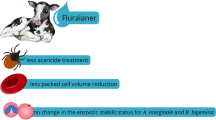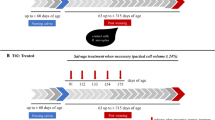Summary
Crossbred dairy heifers on a farm in an East Coast fever (ECF) endemic area in Malawi were immunised againstTheileria parva, Anaplasma spp.,Babesia bigemina, Babesia bovis andCowdria ruminantium. They were treated at infrequent intervals with chlorfenvinphos to limit infestation with adult ticks, without providing complete tick control. In one trial, which tested a threshold dipping regimen, 20 heifers were dipped only once in 6 months to control a flush ofBoophilus microplus. Unimmunised controls showed serological evidence of exposure toT. parva andB. bigemina, and one died of ECF, but there were no incidents of tick-borne disease in the immunised group. In a second trial, which tested a strategic dipping regimen, 107 animals were dipped 9 times over a 6 month period. Despite heavy challenge byB. bovis and moderate challenge byB. bigemina andAnaplasma spp, demonstrated serologically, there was only a single clinical case of babesiosis. The observations provide encouragement for the introduction of integrated tick and tick-borne disease control programmes in improved cattle in ECF endemic areas.
Résumé
Des génisses hybrides productrices de lait furent immunisées contreTheileria parva, Anaplasma spp.Babesia bigemina, Babesia bovis etCowdria ruminantium dans une ferme située dans une région à East Coast fever (ECF). Elles furent traitées à intervalles irréguliers avec du chlorfenvinphos pour limiter l'infestation des tiques adultes, mais sans pourvoir un contrôle complet sur les tiques. Pendant une expérience, qui testa le seuil limite du lavage avec des acaricides, 20 génisses furent lavées une seule fois en 6 mois pour maîtriser l'infestation parBoophilus microplus. Les contrôles, non immunisés, montrèrent des preuves sérolôgiques d'exposition àTheileria parva etBabesia bigemina, et une genisse mourut d'ECF, mais aucun problème de maladie liée aux tiques ne fut observé dans le groupe immunisé. Lors d'une seconde expérience, testant une approche stratégique du lavage avec acaricide, 107 animaux furent lavés neuf fois en six mois. Malgré une infection importante parB. bovis et modérée parB. bigemina etAnaplasma spp., prouvée par étude sérologique, il n'y eut qu'un cas de babésiose. Les observations encouragent l'introduction de programmes de contrôle des tiques et de leurs maladies associées pour améliorer le bétail dans les zones endémiques à ECF.
Resumen
Se inmunizaron terneras lecheras cruzadas frente aTheileria parva, Anaplasma spp.,Babesia bigemina, Babesia bovis yCowdria ruminantium. El experimento se realizó en una granja situada en una zona de Malawi en la que la fiebre de la costa este es endémica. Los animales se trataron de forma infrecuente con clorfenvinfos para limitar la carga de garrapatas adultas, pero no se llevó a cabo ningún programa completo de control de garrapatas. El primer ensayo tuvo como objetivo determinar la frecuencia minima de baños antigarrapata. Un total de 20 terneras recibieron un único baño a lo largo de 6 meses para controlar un aumento en la carga deBoophilus microplus. Los animales control que no habían sido inmunizados mostraron evidencia serológica de exposición aTheileria parva y uno de ellos murió de fiebre de la costa este. Sin embargo, en el grupo de animales inmunizados no se detectó ningún caso de enfermedad transmitida por garrapatas. El segundo experimento tuvo como objetivo comprobar la eficacia de un programa estratégico de baños antigarrapata. Un total de 107 animales fueron bañados 9 veces a lo largo de 6 meses. Si bien se demostró serológicamente una fuerte infestación porBabesia bovis y una infestación moderada porB. bigemina yAnaplasma spp, ningún animal enfermó de babesiosis. Estas observaciones sugieren la conveniencia de introducir programas de control integrados de garrapatas y enfermedades transmitidas por garrapatas en ganado vacuno mejorado en zonas donde la fiebre de la costa este es endémica.
Similar content being viewed by others
References
Anon, (1991). FAO/DANIDA Tick and Tick-borne Diseases Programme Second Review Meeting (Phase II), Kampala, Uganda, September 1991. Rome. Food and Agriculture Organization of the United Nations. 60 pp.
Bezuidenhout, J. D. (1989).Cowdria vaccines. In:Veterinary Protozoan and Hemoparasite Vaccines. (Ed. I. G. Wright). Boca Raton, Florida. CRC Press, pp 31–42.
Callow, L. L. &Dalgliesh, R. J. (1979). The development of effective, safe vaccination against babesiosis and anaplasmosis in Australia. In:Proceedings of 56th Annual Conference of Australian Veterinary Association, pp 4–8.
Johnston, L. A. Y., Haydock, K. P. &Leatch, G. (1981). The effect of two systems of cattle tick (Boophilus microplus) control on tick populations, transmission ofBabesia spp. andAnaplasma spp. and production of Brahman crossbred cattle in the dry tropics.Australian Journal of Experimental Agriculture and Animal Husbandry,21, 256–267.
Lynen, G. M., Makala, L. H. C. &Pas, W. M. (1993). East Coast fever immunization in Eastern Province, Zambia. In:Ticks and Tick-borne Disease Control. (Ed. T. T. Dolan). International Laboratory for Research on Animal Diseases, Nairobi, pp 16–21.
Norval, R. A. I., Perry, B. D. &Young, A. S. (1992).The Epidemiology of Theileriosis in Africa. Academic Press, London, 481 pp.
Pegram, R. G., Tatchell, R. J., de Castro, J. J. Chizyuka, H. G. B., Creek, M. J., McCosker, P. J., Moran, M. C. &Nigarura, G. (1993). Tick control: new concepts.World Animal Review,74–75, 2–11.
Radley, D. E. (1981). Infection and treatment method of immunization against theileriosis. In:Advances in the Control of Theileriosis. (Eds A. D. Irvin, M. P. Cunningham and A. S. Young). Martinus Nijhoff Publishers, The Hague, pp 227–237.
Soldan, A. W. &Norman, T. L. (1994). Livestock Disease Evaluation Project Dipping Trial: 1993 Report. Lilongwe. Central Veterinary Laboratory. Mimeo. 104 pp.
Spickett, A. M. (1994). Genetic resistance of livestock to infectious diseases and parasites. In:Infectious Diseases of Livestock with Special Reference to Southern Africa. Vol. 1. (Eds J. A. W. Coetzer, G. R. Thomson and R. C. Tustin). Oxford University Press, Cape Town, pp 143–151.
Author information
Authors and Affiliations
Rights and permissions
About this article
Cite this article
Lawrence, J.A., Musisi, F.L., Mfitilodze, M.W. et al. Integrated tick and tick-borne disease control trials in crossbred dairy cattle in Malawi. Trop Anim Health Prod 28, 280–288 (1996). https://doi.org/10.1007/BF02240818
Accepted:
Issue Date:
DOI: https://doi.org/10.1007/BF02240818




